Infantry Equipment, Australian Pattern (Leather) - Cartridge carriers
Who would have believed it was this involved?
 As has been previously noted, the history of the Infantry Equipment, Australian Pattern (Leather) is, poorly documented at best. The Cartridge carriers in particular seem have had a complicated history. I have been told that the Cartridge carrier development may have stated as early as 1912, and that records exist in the Australian National Archives that trace the evolution of the Cartridge carriers from 1913 to July 1917. There is still a good bit of controversy about this. At present, Karkee Web has not seen any documentary or photographic evidence of Australian Pattern Cartridge carriers prior to 1915. Research is ongoing, though, as noted below.
As has been previously noted, the history of the Infantry Equipment, Australian Pattern (Leather) is, poorly documented at best. The Cartridge carriers in particular seem have had a complicated history. I have been told that the Cartridge carrier development may have stated as early as 1912, and that records exist in the Australian National Archives that trace the evolution of the Cartridge carriers from 1913 to July 1917. There is still a good bit of controversy about this. At present, Karkee Web has not seen any documentary or photographic evidence of Australian Pattern Cartridge carriers prior to 1915. Research is ongoing, though, as noted below.
Australian Karkee researcher Graham Tweeddale has been examining one particular document, NAA file Test of infantry Equipment Leather, Series MP 367/1 Control Symbol 402/7/13, which seems to cover tests conducted in 1916 - 1917. Because of copyright restrictions, Karkee Web will not be able to reproduce this entire document here, but for now, here are some things relating to Cartridge carriers that he has learned:
(a) There are three type of Cartridge carrier mentioned. On 4/4/16 “Note. Two patterns are on issue – one fastening ?? with a securing strap & the latest pattern which is similar in shape to the web, but has two studs in front.”
Comment: This suggests that the spring loaded type were no longer on issue by early 1916, if indeed they were ever on general issue. It also tells us that the type with the stud flap fastenings are earlier than the snap type, instead of later as we had previously guessed. Based on photographic evidence, there are two types "with a securing strap": one that has a very short strap that fastens at the top, and a second that fastens on the front of the pocket.
(b) All leather equipment was manufactured with tongued buckles “since July last” ( July 1916).
Comment: Significant, since so many examples are undated.
(c) Later there is mention of the “dome fasteners” replacing the studs. Graham notes that (b) and (c) seem to have taken place at more or less the same time.
Comment: Read together, (b) and (c) suggest to that the three earliest type carriers, the (1st) "spring" , (2nd) "short strap", and (3rd) "long strap" types, may have only had the tongueless buckles; the (4th) "stud" type was perhaps made in both tongued and tongueless versions, while the (5th) "snap" type may have been made in a tongued version only.
(d) There is considerable criticism throughout the tests that the cartridge carriers sag when full & that bayonet frog tended to slid around to the front. Graham suggests that these criticisms were probably the reason why the Patt. '08 style wrap around straps were added.
Comment: If Graham's guess is right, then the "snap & strap" version is the 6th (and probably last) variation. In addition, another source has noted the additional straps as present on left side Carriers only.
Please note that all of comments above must be read as conjectural only - this is a great deal of conclusion from a small bit of evidence. It is enough, though, to require rewriting and revising this entire page. The page has been rearranged to reflect the six variation sequence shown below. Take what is written below as a best guess for now: no one on the Karkee Web Research Team would be surprised to learn that it is in error in places. This is an area where a lot of research is currently being done, so expect changes, updates, and much more solid evidence in future. Naturally, if any reader can supply further information, especially documents and photographs, we would be delighted to include it here.
Infantry Equipment, Australian Pattern (Leather) Cartridge carriers, Proposed Sequence:
- 1st issue: "Mousetrap" spring closure, possibly trials or limited issue only
- 2nd issue: Short strap, stud closure
- 3rd issue: Long strap, stud closure
- 4th issue: Flap cover, stud closure
- 5th issue: Flap cover, snap closure
- 6th issue: Flap cover, snap closure, Patt. '08 style securing straps around belt
All Australian Pattern Cartridge carriers, regardless of the issue, differ from Patt.'08 in the method by which they attach to the Belt. The Patt. '08 Cartridge carrier uses 3-inch brass double hooks to secure it in place, supplemented by two small web straps that wrap under the Belt and snap to the Carrier. Instead of these hooks, the Australian Pattern Carrier has a large brass stud on each end. These are passed through matching holes in the Belt. A leather strap attached to the Carrier is then wrapped around the front and fixed to each stud, thus locking the Carrier in place.
Note: The photo at the start of this section, supplied by Leigh McCann, shows Infantry Equipment, Australian Pattern (Leather) being used in training during WW II. We may not, as yet, be able to pinpoint exactly when development started, but we can confidently say that it was used in both World Wars.
Carrier, cartridge, 75 Rounds, first issue
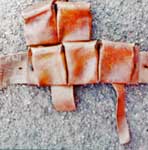
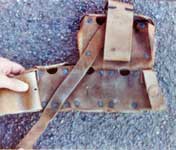 The first issue Cartridge carriers for the Australian Pattern (Leather) Infantry Equipment. As the detail below left shows, the pockets are opened and closed using a steel "mousetrap" spring arrangement on the inside. This pair have tongueless buckles. This unique design seems to have been short lived. These are the only contemporary photographs of this type of Carrier that Karkee Web has seen. It may well be that this was a trials version only, and it may not ever have been on general issue.
The first issue Cartridge carriers for the Australian Pattern (Leather) Infantry Equipment. As the detail below left shows, the pockets are opened and closed using a steel "mousetrap" spring arrangement on the inside. This pair have tongueless buckles. This unique design seems to have been short lived. These are the only contemporary photographs of this type of Carrier that Karkee Web has seen. It may well be that this was a trials version only, and it may not ever have been on general issue.
 A pair of Australian Pattern (Leather) Infantry Equipment Cartridge carriers. The left Carrier is the same one shown above.
A pair of Australian Pattern (Leather) Infantry Equipment Cartridge carriers. The left Carrier is the same one shown above.
 A detail showing the unique internal springs. Also note that three is no securing strap at all on this type of Carrier. All photos of these first issue Carriers are © Ross Torrington 2009.
A detail showing the unique internal springs. Also note that three is no securing strap at all on this type of Carrier. All photos of these first issue Carriers are © Ross Torrington 2009.
Carrier, cartridge, 75 Rounds, second issue

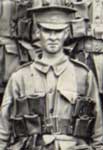 The second issue Cartridge carriers for the Australian Pattern (Leather) Infantry Equipment. The "short strap" variation is the earlier of the two types that the Test of infantry Equipment Leather could be referring to as fastening "with a securing strap". Karkee Web has not seen any contemporary examples of this type of Carrier. The photo far left is taken from Alfred A. Kruk's Patronentaschen, Patronengürtel and Banduliere 1850 - 1950, p.8. The photo near left is courtesy of Graham Tweeddale; it shows the 8th Reinforcements, 22th Battalion, probably in early 1916.
The second issue Cartridge carriers for the Australian Pattern (Leather) Infantry Equipment. The "short strap" variation is the earlier of the two types that the Test of infantry Equipment Leather could be referring to as fastening "with a securing strap". Karkee Web has not seen any contemporary examples of this type of Carrier. The photo far left is taken from Alfred A. Kruk's Patronentaschen, Patronengürtel and Banduliere 1850 - 1950, p.8. The photo near left is courtesy of Graham Tweeddale; it shows the 8th Reinforcements, 22th Battalion, probably in early 1916.
Carrier, cartridge, 75 Rounds, third issue
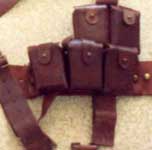
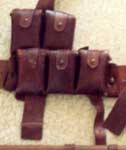
 The third issue "long strap" Cartridge carriers for the Australian Pattern (Leather) Infantry Equipment. This is the second type that the Test of infantry Equipment Leather may be referring to as fastening "with a securing strap". These Carriers have tongueless buckles. From the Ross Torrington collection. Photos © Ross Torrington 2009.
The third issue "long strap" Cartridge carriers for the Australian Pattern (Leather) Infantry Equipment. This is the second type that the Test of infantry Equipment Leather may be referring to as fastening "with a securing strap". These Carriers have tongueless buckles. From the Ross Torrington collection. Photos © Ross Torrington 2009.
The photo at right, supplied by Grant Napier, shows a digger wearing what appears to be a mixed set. The left, clearly visible, Carrier is the "long strap" type. His right Carrier is less distinct, but appears to be the "short strap" variety.

 Another example of the third issue Cartridge carrier, showing the front and rear views. Photos © Bill Lennell 2009.
Another example of the third issue Cartridge carrier, showing the front and rear views. Photos © Bill Lennell 2009.
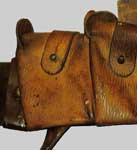 A detail showing the strap and stud closure on a third issue Cartridge carrier. Photo © Bill Lennell 2009.
A detail showing the strap and stud closure on a third issue Cartridge carrier. Photo © Bill Lennell 2009.
Carrier, cartridge, 75 Rounds, fourth issue
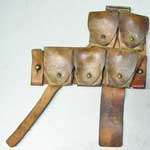
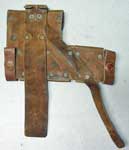 In this version, the fourth issue Cartridge carrier, the pillar studs on the pouches push through "buttonhole" slots in the cover flaps. With its larger covers on the pockets, the fourth issue Carrier really looks like the Patt. '08 Cartridge carrier made in leather. This Carrier has a tongued buckle. This example is a right Cartridge carrier, no maker's mark or date, but it is stamped "AUSTRALIA". Photos © 2007 by Brian J. Burns.
In this version, the fourth issue Cartridge carrier, the pillar studs on the pouches push through "buttonhole" slots in the cover flaps. With its larger covers on the pockets, the fourth issue Carrier really looks like the Patt. '08 Cartridge carrier made in leather. This Carrier has a tongued buckle. This example is a right Cartridge carrier, no maker's mark or date, but it is stamped "AUSTRALIA". Photos © 2007 by Brian J. Burns.
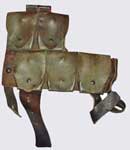
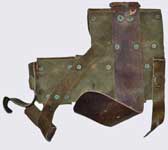 Another fourth issue Cartridge carrier, this time a left one. It also has a tongued buckle. From the Grant Napier Collection. Photos © 2008 by Grant Napier.
Another fourth issue Cartridge carrier, this time a left one. It also has a tongued buckle. From the Grant Napier Collection. Photos © 2008 by Grant Napier.
Carrier, cartridge, 75 Rounds, fifth issue

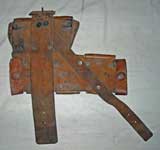 This fifth issue right Cartridge carrier is typical of the type. In the fifth issue the pillar studs on the pouches are replaced by fastener spigots, and there are fastener crowns on the cover flaps. The fastener crowns are mated to one of two spigots on each pouch, depending on how many chargers are in the pocket. The tongued buckle and the adjustment holes in the straps are also visible. This example is undated and is maker marked "C.G.H.F. " (Commonwealth Government Harness Factory).
This fifth issue right Cartridge carrier is typical of the type. In the fifth issue the pillar studs on the pouches are replaced by fastener spigots, and there are fastener crowns on the cover flaps. The fastener crowns are mated to one of two spigots on each pouch, depending on how many chargers are in the pocket. The tongued buckle and the adjustment holes in the straps are also visible. This example is undated and is maker marked "C.G.H.F. " (Commonwealth Government Harness Factory).
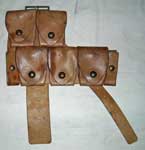
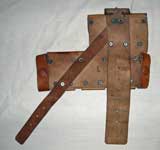 This is a fifth issue left Cartridge carrier. It is undated and maker marked "JH".
This is a fifth issue left Cartridge carrier. It is undated and maker marked "JH".
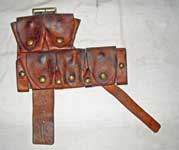
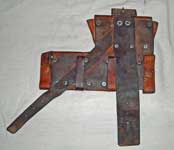 Here is an example of the sixth issue left Cartridge carrier. It differs from the earlier Carriers shown in that it has Patt. '08 style straps that wrap around the bottom of the Belt and snap to spigots on the front of the Carrier. This change is conjectured to be a response to critical remarks in the Test of infantry Equipment Leather, that the Cartridge carriers sagged on the belt when full. One researcher has noted that he has observed this variation only on left Carriers. It is unclear why this would be so; if anyone can supply a photo of a right Carrier with the additional straps, it would be greatly appreciated. This Carrier is undated and is maker marked "C.G.H.F. "
Here is an example of the sixth issue left Cartridge carrier. It differs from the earlier Carriers shown in that it has Patt. '08 style straps that wrap around the bottom of the Belt and snap to spigots on the front of the Carrier. This change is conjectured to be a response to critical remarks in the Test of infantry Equipment Leather, that the Cartridge carriers sagged on the belt when full. One researcher has noted that he has observed this variation only on left Carriers. It is unclear why this would be so; if anyone can supply a photo of a right Carrier with the additional straps, it would be greatly appreciated. This Carrier is undated and is maker marked "C.G.H.F. "